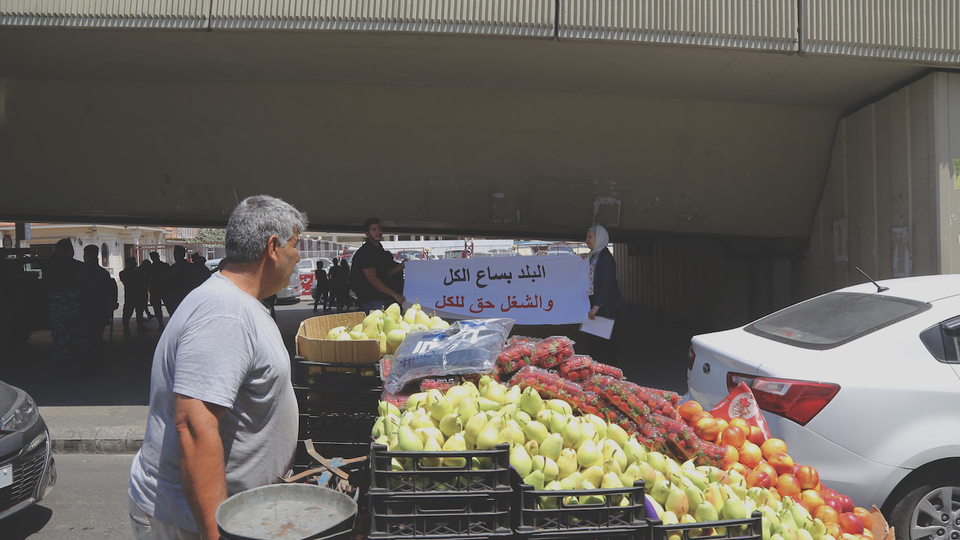Did Someone Say Workers? (Part 1 of 2)
Day 47: Monday, December 2, 2019
Socioeconomic demands have been voiced by protesters in Lebanon’s uprising from Day 1. Slogans such as “This is not corruption, this is neoliberalism” have peppered protest signs. But a question emerges amidst these rising contestations: Where is Lebanon’s organized labor and why are the trade unions dormant? The General Confederation of Workers in Lebanon (GCWL) has not called for any strikes or demonstrations, and it waited 19 days after the onset of the protests to issue a brief statement. The conspicuous absence of Lebanon’s labor movement is critical at this juncture; we know that labor mobilization played a crucial role in Egypt and Tunisia’s 2011 revolutions, and that it is a key feature of Sudan’s ongoing uprising. To understand the absence of labor in Lebanon’s revolutionary moment, we must turn to three factors: the assault of post-civil war neoliberal economic policies on Lebanese labor, an inhospitable legal environment, and organizational problems within the labor movement itself.
Neoliberal economic policies adopted since the end of the civil war gutted a labor movement that had succeeded in improving working and living conditions, especially throughout the 1960s and early 1970s. Fierce trade liberalization and reliance on foreign capital and remittances deformed the economy and labor market. Soaring debt service precipitated monetary and fiscal policies that crowded out the productive sector. The activity rate — the share of the population above 15 who are working or actively looking for a job — has remained stagnant and low (around 50 percent). The vast majority of enterprises are micro-sized (employing fewer than five workers), which has a negative impact on labor organizing given the limited capacity for association of workers in small enterprises. Migrant workers as well as workers in informal employment, who make up almost 40 percent of the total workforce, are excluded from labor organizing.
To understand the absence of labor in Lebanon’s revolutionary moment, we must turn to three factors: the assault of post-civil war neoliberal economic policies on Lebanese labor, an inhospitable legal environment, and organizational problems within the labor movement itself.
In addition to restrictive labor market features, legal shackles tame the labor movement. Lebanon never ratified the International Labor Organization Convention No. 87 of 1948 on Freedom of Association and Protection of the Right to Organize, which eliminates any requirement that union formation be preauthorized. Moreover, the 1946 Lebanese Labor Code significantly limits freedom of association: According to Article 86, no trade unions may be established without prior authorization from the Ministry of Labor; according to Article 50, the only union members protected from dismissal are those elected as union board members.
The labor movement is also hamstrung by a problematic organizational structure. It is represented by the GCWL, an umbrella organization comprising around 60 federations, each of which groups trade unions together without concern for whether they operate in the same sector or geography. One of the main weaknesses of this structure is its low representativeness of the labor force. The 400 trade unions currently considered to be active (i.e., they hold regular elections) comprise only 6 percent of the country’s total labor force. The GCWL is also internally undemocratic. For instance, federation representatives are charged with electing the GCWL’s president, but they themselves are appointed by the federation’s leadership rather than elected by its members. Attempts to democratize the GCWL’s 1970 charter have repeatedly failed, leaving room for political intervention and manipulation.
The ruling elite has not hesitated to capitalize on these weaknesses. Tactics include: withholding budget allocations to the GCWL from the Ministry of Labor; facilitating the authorization of those federations affiliated to ruling political parties; and electoral interference at the union, federation, and Confederation level. By the late 1990s, the GCWL had become an extension of the ruling elite’s interests and its positions continue to be severed from the conditions and demands of the workforce it claims to represent. By way of illustration: In 2011, the GCWL opted not to support an unprecedented hike in the monthly minimum wage for private sector employees, from $333 to $580 (proposed by the minister of labor at the time, Charbel Nahas, as part of a progressive reform package). Instead, the GCWL sided with business associations to support Prime Minister Najib Mikati’s proposal of capping it at $450.
Political interference in labor organizing is not limited to the GCWL and the private sector. The Union Coordination Committee (UCC) that represents public sector employees has also been co-opted in recent years, largely as a reaction to its past successes.
Aided by its democratic and centralized structure, and propelled by an enormous contingent of civil servants (around 130,000), the UCC led a successful campaign between 2012 and 2017 to demand a new salary scale. Success came despite the fact that, like private sector workers, public sector employees face legal obstacles to organizing. Civil servants are forbidden from directly engaging in political affairs, joining a political party, or participating in strikes. According to Article 65 of Law Decree No. 112, a civil servant’s participation in a strike is akin to a resignation. As a reaction to the mobilization that culminated in a new salary scale, candidates affiliated to ten political parties allied to successfully oust UCC representatives in the next elections.
It is in this labor landscape that a group of professionals, including university professors, journalists, engineers, and physicians have begun organizing under the umbrella of the newly-formed Lebanese Association of Professionals. Inspired by the Sudanese Association of Professionals, they have used the momentum of the October protests to coordinate alternative labor movements, and have called for protests against the GCWL at its headquarters. Part 2 of this series will explore the emergence of these nascent associations, and the new expressions of labor contestation that have already become a distinctive element of the October Revolution.
